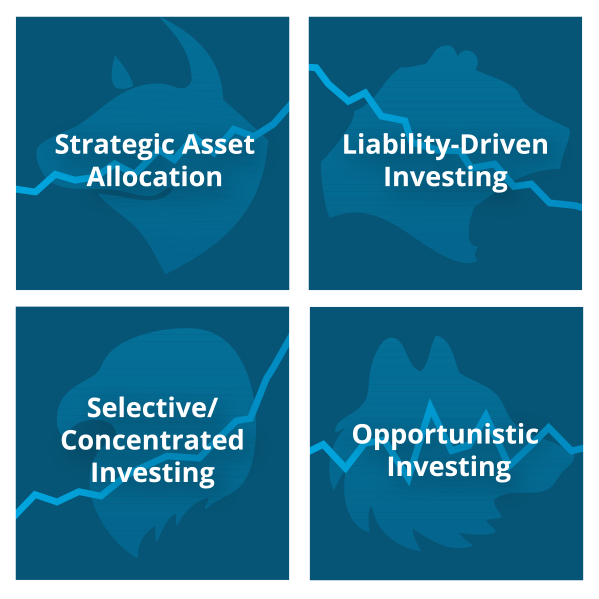

Liquid Transparent Alternatives to Hedge Funds and Private Equity
"Gaining exposure to low-correlation diversifying investment methods such as Hedge Funds and Private Equity Limited Partnerships is fraught with difficulties. But there are alternatives to getting exposure to these strategies and risk premiums."
Learn more about Liquid Transparent Alternatives to Hedge Funds and Private Equity
Traditionally, investors' portfolios consist primarily of stocks and bonds. Experts view these assets as the backbone of an investment portfolio, which have historically paid off over time.
But with the burst of the dot-com bubble and the 2008 financial crisis, some investors have chosen to diversify their portfolios with what are sometimes termed liquid alternative investments. Read on to learn about the role of liquid alternative investments in a portfolio.
What Are Liquid Alternative Investments?
Liquid alternative investments (sometimes called liquid alts) may come in the form of ETFs, mutual funds, closed end funds, or separately managed accounts (SMAs). They're "alternative" inasmuch as the underlying assets within these investment vehicles are either not the three traditional asset types (stocks, bonds or cash), or they’re managed according to a strategy that would normally be found in a non-liquid vehicle such as a hedge fund or private equity fund.
They're liquid inasmuch as they typically offer daily liquidity: these investments can be sold or redeemed within one business day. This is a major change from many alternative investments, which provide a "gate" window in which an investor can take money out of the fund only during specific time periods.
Liquid alternative investments may have a lower barrier-of-entry than many other alternative investment vehicles as well. Traditional alternative investments expect the investor to be an accredited investor by the SEC's definitions, with an annual income of more than $200,000, or at least $1,000,000 in savings excluding one's current residence. But there are no such restrictions with liquid alternative investments.
While it is not an apples-to-apples comparison in terms of services delivered, many liquid alternatives tend to have higher internal fees and expenses than traditional stock and bond investments by virtue of their more esoteric underlying assets and strategies, which may be more difficult/expensive to get exposure to and more complex to manage for the provider. However, when comparing publicly offered liquid alternatives versus traditional limited partnership structured alternatives (a closer comparison), the former tend to be less expensive and more transparent in terms of the underlying holdings.
Accessibility
When the financial crisis of 2008 hit, investors scrambled to remove their money from all sorts of assets that they suddenly realized were riskier than expected. But to the surprise of many investors in traditional alternative vehicles, it was not possible to take cash from their fund, even if they needed the money at the time to pay short term expenses. There is a school of thought (in behavioral finance) that says it is better for a long term investor to have lock-up periods on their investments, because this prevents them from making knee-jerk decisions in times of market stress that would cause them to lose money. But while pulling assets out of the market into cash while the market is declining is not necessarily the wisest of moves from an investment management standpoint, common sense dictates that the average investor simply prefers the freedom of having immediate access to their money rather than the shackles of lock up periods, for a variety of reasons that may be related to perfectly sound investment principles (and not just short-termism).
The financial crisis was an eye-opener for many investors and advisors. In its wake, these individuals have sought investment vehicles that offer greater flexibility and more liquidity.
Different Risk-Reward Characteristics
By virtue of being alternative investments, liquid alt investments offer risk profiles that are intended to differ substantially from more traditional investment types. Hatteras Funds writes:
"Over the past 15 years, a 60-percent stock/40-percent bond portfolio ... had a near-perfect 0.98 correlation to the S&P 500 TR Index. This means the portfolio's value moved almost in lockstep with the S&P 500's performance over this time."
That's great news when the market is bullish, but a portfolio with that description will obviously suffer in a bear market. By diversifying one's investment types into alternative assets or strategies that have the potential to zig when the market zags, one can create a portfolio that has the potential to better weather stock market downturns and volatility.
History shows that most liquid alt strategies will not outperform the stock markets on a returns basis over the long term...
While liquid alts can act as a source of low-correlation returns when used judiciously as an element within a larger traditional stock/bond portfolio, they can be a source of elevated risk and angst if used improperly (or viewed improperly). This is especially true if they’re viewed as a separate portfolio under the expectation that they’ll outperform the stock markets. History shows that most liquid alt strategies will not outperform the stock markets on a returns basis over the long term, and thus they should not be chosen under the expectation that they will. Instead, investors should be realistic about the outcomes they expect from their liquid alts and accept that their inclusion in an overall portfolio is meant more for the purposes of diversifying into different risk types rather than beating the market.
Leverage
Leverage is a tactic that's often used in conjunction with liquid alternative investments, which makes them an enticing proposition for some investors. Leverage is the process of using borrowed capital to make investments which would otherwise be unavailable to them with their normal capital alone.
When things go right, leverage allows investors to potentially amplify the returns of the portfolio. However, using leverage is a risky investment approach, and can magnify a portfolio's losses when things go the wrong way.
Like any investments, liquid alternative investments aren't perfect. They should be chosen carefully, with the help of trusted financial advisors. Investors should confer with their financial advisors frequently to communicate changes to their objectives and to determine whether a particular investment is appropriate. With these caveats mind, liquid alternative investments may provide a useful way to further diversify one's portfolio beyond traditional stocks and bonds.






Leave a Comment